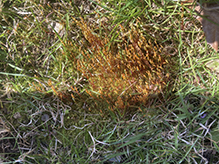tinyleaf small plume moss
(Haplocladium microphyllum)
Conservation • Description • Habitat • Ecology • Use • Distribution • Taxonomy
Conservation Status |
|
|||||||
| IUCN Red List | not listed |
|||||||
| NatureServe | NNR - Unranked SNR - Unranked |
|||||||
| Minnesota | not listed |
|||||||
Description |
||
Tinyleaf small plume moss is a common and widespread moss. It occurs in Europe, Asia, the Indian Subcontinent, and the Americas. In the United States it occurs from Maine to North Dakota south to Florida and Arizona. It is common in Minnesota, where it is one of the five most common mosses found in moderately moist (mesic) hardwood forests. It is frequently found in mixed floodplain or wet forests and in shrubby meadows. It is occasionally found in forested peatlands, in conifer swamps, and along river shores. It is usually seen as a dense carpet growing on rotting wood or woody debris. Sometimes small patches grow among other mosses on deciduous trees. It also grows on shaded trails, where it is resistant to trampling. Tinyleaf small plume moss is a medium-sized, ribbed, upland, carpet-forming (pleurocarpous) moss. The stems are elongated, much branched, and sharply pointed at the tip. The branches are unevenly arranged on opposite sides of the stem (pinnately branched). The branches are themselves unbranched. The stems and branches are sparsely covered with small greenish scales (paraphyllia). The paraphyllia are thread-like and unbranched. The leaves are broadly egg-shaped to triangular and 1⁄32″ to 1⁄16″ (0.8 to 1.5 mm) long. They are somewhat distantly spaced compared to other mosses. They are erect, bend slightly, and are swept to one side. They are frequently pleated with two folds at the base. When dry they frequently have a long, extended, flexible tip. The leaf vein forms a single midrib (costa) that ends shortly before the leaf tip. The margins are mostly flat, slightly bent backward near the base, and extend down the stem slightly below the point of leaf insertion. They are toothed with minute, sharp, forward-pointing teeth. A single spore-bearing reproductive structure (sporophyte) rises from the tip of a small branchlet that is well below the tip of a major branch. The sporophyte is a small capsule at the end of a long stalk (seta). The seta is slender and smooth. The capsule is held inclined to horizontal. At the end of the capsule there is an obliquely angled opening. When immature the capsule opening (mouth) is covered with a membranous hood (operculum) and a large, smooth cap (calyptra). The operculum is cone-shaped with a short beak-like projection. The capsule is oblong and curved. As it matures, the capsule develops a ring around the opening (annulus). When mature, the annulus forces the operculum and calyptra to drop off exposing the capsule opening. Around the opening there are two rings of teeth, each with 16 teeth. The outer (exostome) teeth are lance-shaped, are covered with short rounded bumps (papillae), and are crossed with fine parallel lines (striate) near the base. The inner (endostome) teeth are more delicate. They have a high basal membrane and a well-developed fringe of hairs (cilia) on the margin. The spores are smooth and 8 to 12 microns in diameter. |
||
Growth Form |
||
Pleurocarp |
||
Height |
||
Prostrate |
||
Similar Species |
||
Habitat |
||
Moderately moist. Deciduous and mixed forests. On rotting wood, woody debris, and shaded trails. |
||
Ecology |
||
Phenology |
||
Capsules mature year-round |
||
Use |
||
|
||
Distribution |
||||
|
Sources Janssens, J.A. 2014. Noteworthy Mosses & Liverworts of Minnesota, Part II: Species Fact Sheets. Minnesota Department of Natural Resources 2014, 208 pp. |
|||
| 5/5/2023 | ||||
Nativity |
||||
Native |
||||
Occurrence |
||||
Common |
||||
Taxonomy |
|||
| Kingdom | Plantae (Plants) | ||
| Division | Bryophyta (Mosses) | ||
| Subdivision | Bryophytina (Moss) | ||
| Class | Bryopsida (Joint-toothed Mosses) | ||
| Subclass | Bryidae | ||
Order |
Hypnales (Feather Mosses) | ||
Family |
Leskeaceae | ||
Genus |
Haplocladium | ||
Synonyms |
|||
Bryohaplocladium microphyllum Thuidium lignicola Thuidium microphyllum |
|||
Common Names |
|||
tinyleaf small plume moss |
|||
Glossary
Annulus
On mosses: a ring of cells around the capsule opening beneath the operculum.
Calyptra
On mosses: A thin cap that covers and protects the capsule and operculum and drops off at maturity.
Costa
On ferns: The central axis of a pinna, to which pinnules are attached. On mosses: the central axis (midvein) of a leaf. On insects: The vein on the leading edge of the forewing.
Operculum
On mosses: A lid or cover that covers the opening of a capsule and detaches at maturity.
Pinnate
On a compound leaf, having the leaflets arranged on opposite sides of a common stalk. On a bryophyte, having branches evenly arranged on opposite sides of a stem.
Visitor Photos |
|||||
Share your photo of this plant. |
|||||
| This button not working for you? Simply email us at info@MinnesotaSeasons.com. Attach one or more photos and, if you like, a caption. |
|||||
Karen Smith |
|||||
 |
 |
||||
Nancy Falkum |
|||||
 |
|||||
MinnesotaSeasons.com Photos |
|||||
|
|||||

Slideshows |
||

Visitor Videos |
|||
Share your video of this plant. |
|||
| This button not working for you? Simply email us at info@MinnesotaSeasons.com. Attach a video, a YouTube link, or a cloud storage link. |
|||
Other Videos |
|||

Created: 12/27/2021
Last Updated:



